 Loading... Please wait...
Loading... Please wait...
Trick from the Vault #1 - String Restoration Revisited
Posted by Chuck Leach on 31st May 2016
String Restoration Revisted
One of my earliest favorite pocket tricks was a string restoration from Harry Lorayne’s Big Book of Magic. In that rendition, the performer holds two separate pieces of string in one hand, then restores them into a single piece. The restoration can happen in a spectator’s hand. This simple effect always got a big reaction. Though it always played well, I never liked the start. While the two strings appear to be separate, they were only a half inch apart in the same hand, never any further from the start until the end. It also lacked a logical beginning. The fact that you have two, pre-cut, same-length strings in your pocket, suggests those were special strings for a special purpose. Its advantage is it can be performed anywhere. My version has limitations.
I came up with this version, about 25 years ago, to fool a magician friend who was familiar with the old method.
Effect: The performer brings out a spool of string and cuts off approximately 24 inches (or he simply shows a 24 inch piece). He (really) cuts this piece in half, making two 12 inch pieces that he shows in opposite hands. He magically restores them into one piece.
Your Needs
The String: Acquire some standard white parcel string. It comes in various numbers of strands. You want a string that has an even number of strands. Odd numbers will work, but even, typically 4 or 6, is best. Eight strands is ridiculously good, if you can find it.
If your string comes on a small spool you can put in your pocket or magic case, great. Otherwise, cut a 2” x 1” piece of cardboard and wrap 20 feet of string around it.
The Set-up
Unwind 36 inches of string and cut it off the spool. 12 inches from one end, separate the strands. The string in the picture is made up of four strands. When an opening is made, there are two strands on each side. I find it easy to push a pencil into a small opening, then force it open more, so each side of the opening can be pulled out an inch. Let go and they automatically twist into two new ‘fake’ ends. Twist them with your fingers a little and they look perfect. A shows the start, B shows the result.)
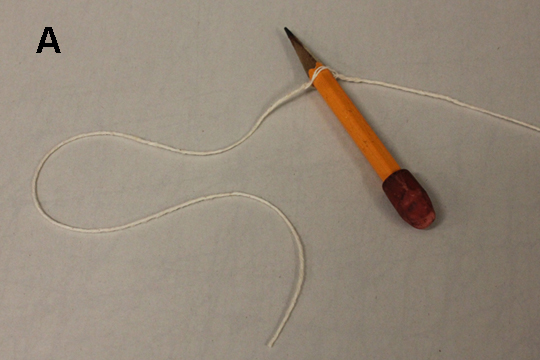
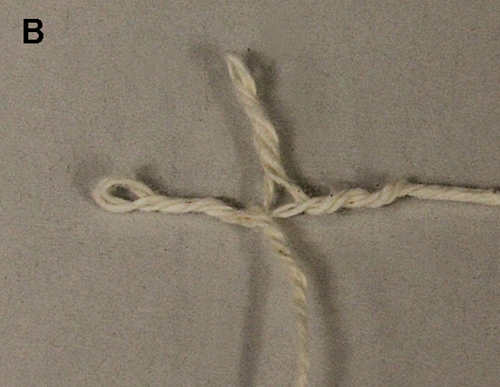
Photo C shows the string with the new fake ends. Curl the short piece into a small coil. D shows the short piece coiled. E is a close-up.
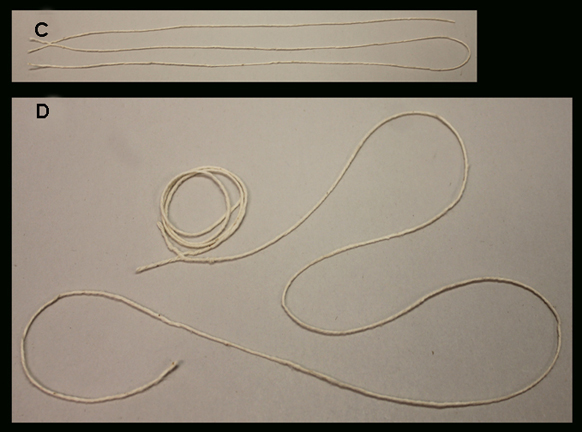
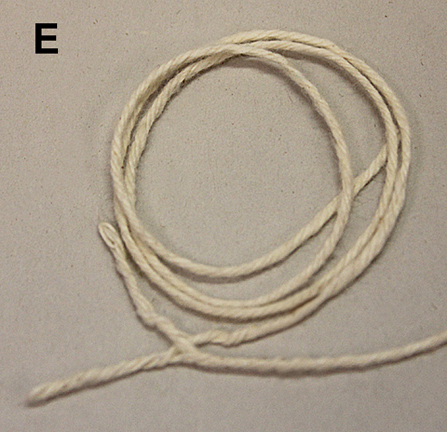
Note: If you want, instead of using a 36” piece of string, you can leave the string attached to the spool. Make the fake ends 12 inches down the string was above, coil the short string, then use a rubber band to keep the coil in place on the side of the spool.
Performing situation: You need to be in a situation where you can lap or ditch a 12 inch piece of string. I’ve performed this at a table, behind a bar, kneeling beside a coffee table and in front of a crowd, with my close-up case on a table at my side for full frontal ditching.
You will need scissors and a spectator.
Performing
Show the 24 inch piece of string. (If using a spool, show the spool, concealing the coiled string. One hand secretly takes the coil and conceals it, as approximately 24 inches of string is unwound, then cut from the spool.)
The coiled string and one fake end is concealed in your hand. The other fake end is sticking up, so the string looks complete to the spectator (F, Left). Bring the end of the string up to the hand that is holding the coiled string, then cut the string at the bottom of the loop, making two equal pieces. At least that’s how it should look to the spectator.

Set the scissors down and take the regular piece of string with your other hand, showing both pieces completely separate. Put it back into the other hand. (F, Center) The base of the thumb holds the upper part of the coiled string and the one fake end, as well as the straight string.
When you bring the two pieces of string together, point out to your spectators how the strings seem attracted to each other. When they bump together, they seem to stick a little, “like they are trying to get back together.”
Put the two strings side by side (F, Center) and stroke them a couple times. On the second stroke, the free hand pinches the straight string near the top while at the same time the middle finger of this hand goes into the coil. (F, Right.)
Stroke the string again, in the direction of your ditch area (your lap, table edge, close-up case). You should be close enough to your ditch area so you don't have to 'reach' to ditch. The ditch area should be a little below or to the side of the bottom of the strings.
At the same time that the thumb and index finger are taking the straight string, the middle finger has uncoiled and pulled down the coiled string. Photo G shows the continuation of action. When the stroking hand is nearly out of sight for a second, it ditches the straight string.
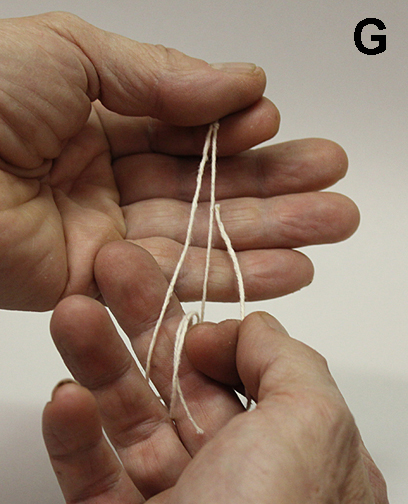
While the above takes place, the thumb and index finger tips of your other hand, squeezes the fake ends and rolls them between the finger tips, so the second end pops up into view.
The switch takes place in an instant and immediately afterward everything looks normal.
Ask your volunteer to put out her hand, Place the two fake ends into her hand so the two real ends of the string go off each side. Close her fingers over the string, making a fist. The real ends of the string should be coming out of each side of her fist. Ask her to hold tight.
Take the two ends and pull them until you feel the string begin to tighten. Ask the spectator to imaging the string ends in her hand ‘knitting’ back together. As you say this pull harder on the strings, making the fake knots unravel. Slide the string back and forth through the spectator’s hands, then lift up as you ask her to open her hand, revealing the restored string. Hold the string tight and ask the spectator to pluck it like a guitar string, to prove there are no trap doors, hinges or other nefarious bits of deception. Pocket the string.
Whether you perform Lorayne's standard routine, or this one, it is a trick that always gets a strong reaction when the string restores in their hands. Some people will put the fake ends into their mouth to 'chew' the ends back together. You can restore the ends in your hand, using a lighter to heat the ends.
Have fun!
